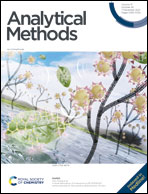High quantum yield nitrogen and boron co-doped carbon dots for sensing Ag+, biological imaging and fluorescent inks†
Abstract
Herein, bright blue-green fluorescent nitrogen and boron co-doped carbon dots (N, B-CDs) with a quantum yield (QY) up to 33.04% were synthesized viahydrothermal treatment from ammonium citrate tribasic and 3-aminophenylboronic acid. The synthesized N, B-CDs showed outstanding water solubility. According to the principle of the static quenching effect (SQE), the synthesized N, B-CDs were utilized as an efficient sensor for sensing Ag+. The linear range and limit of detection (LOD) of the sensor for Ag+ are 0.99–26.04 μM and 9.03 nM (3σ/m). The proposed method was successfully adopted to detect Ag+ in environmental water, which is of great significance to environmental detection. Furthermore, due to the excellent fluorescence performance, the N, B-CDs were found to be an effective tool for biological imaging and as a fluorescent ink, which widens the horizons for the multifunctional applications of N, B-CDs.



 Please wait while we load your content...
Please wait while we load your content...